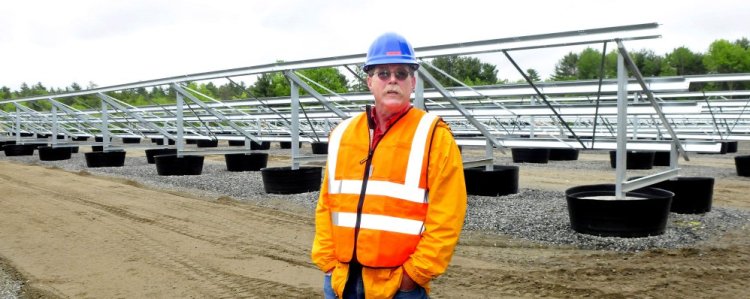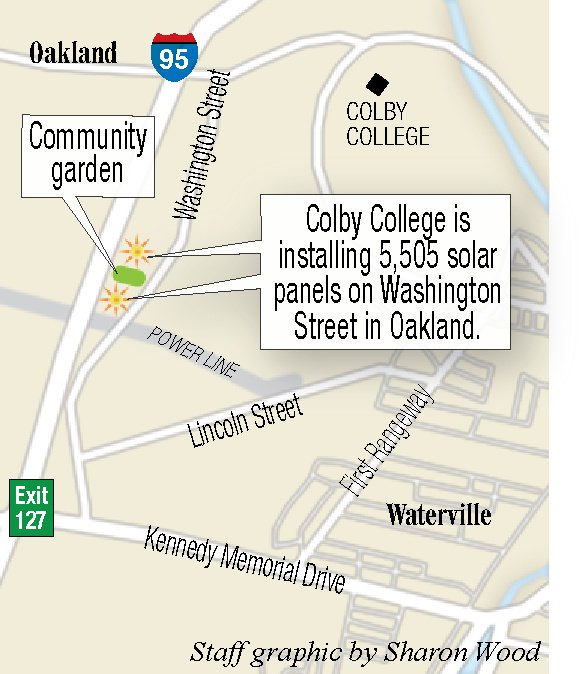WATERVILLE — While the weather Monday afternoon may not have been the most inspiring for solar energy developments, work steadily progressed on Colby College’s 5,300-panel solar array as the college looks to launch a 1.8 megawatt photovoltaic energy project.
Gus Libby, the assistant head of operations and project manager for the solar array, said work can be seen on the southern portion of the field along Washington Street. The solar facility occupies two parts of the field and is separated by a community garden and a storage facility. Work on the northern part of the field, which sits farthest from the road, is still in the grading process.
Colby’s trustees entered into an agreement to lease NRG Energy Inc., a solar energy company based in New Jersey and Texas, about 9 acres of college-owned land along Washington Street for 27 years. Colby owns 26 acres of land in that parcel.
Libby said the college will enter into an agreement with NRG to purchase 100 percent of the power the array produces, which will enable it to cover 16 percent of its energy consumption with the 2.5 million kilowatt hours of electricity the solar power will generate. Colby later would have the option to buy the system outright. Libby said it was hard to say if the college would ultimately buy the system.
Supports for the solar array were about halfway done in the southern field, Libby said, and in the next few weeks, the photovoltaic panels would be installed. He estimated the entire project would be completed sometime in the fall, depending on how cooperative the weather was.
“It’s going well,” Libby said.
As the land sits partially in Oakland, Colby needed the town’s Planning Board to sign off on the development, which it did 5-0 last July. The site was chosen because it is less noticeable from Washington Street, as the land slopes upward. The project is set back 100 feet from a nearby stream and 25 feet from a wetlands area.
Kate Carlisle, director of communications for Colby, said the solar facility was just “one step in a series of steps Colby has taken” and plays an important part in the college’s energy picture.
Mina Amundsen, Colby’s assistant vice president for facilities and campus planning, said the solar facility was another example of Colby’s commitment to sustainability. The college constructed a biomass plant in 2012, which creates relatively cleaner emissions using advanced technology. The college has been carbon neutral since 2013. It has a number of Leadership in Energy and Environmental Design certified buildings.
Amundsen said the college is always looking at ways to further its sustainability. “That’s a constant process,” she said.
The college takes a “holistic approach” toward energy efficiency, she said, which goes beyond just the actual energy produced and involves looking at how other items contribute to sustainability, such as materials involved, water used and waste produced.
Amundsen said the solar facility is “important to teaching and resources” for students, as it is right on campus on a primary approach.
“The education aspect is really critical,” she said.
Besides storage and the community garden, Libby said the area the facility will occupy was hardly used. Occasionally, it was used for transferring fill in and out quickly, but the array is a better use.
“It was sitting there ripe,” he said.
Once completed, the solar array will be fenced in. Libby said the electricity will feed into a main switch, and from there it will go “where it wants to go.”
Colby’s project is one of many in the region. Earlier this year, the town of Madison flipped the switch on the state’s largest solar array. The 26,000-panel array spanning roughly 22 acres in the Madison Business Gateway generates enough electricity to satisfy the needs of about 20 percent of Madison Electric Works customers.
Superintendent Calvin Ames has said that on a sunny day, the farm will meet the needs of “100 percent” of the utility’s customers — about 3,000 homes and small businesses, excluding Backyard Farms. The array was constructed by Ohio-based IGS Solar, and Madison Electric Works purchases all the energy it produces.
Two more large scale utilities are in the works in nearby towns. Fairfield and Clinton have been eyed for farms that would generate enough power for 6,000 out-of-state homes combined and create more than 200 jobs locally.
Ranger Solar, based in Yarmouth, is planning the projects in Fairfield and Clinton to generate 20 megawatts of power each, which will be sold to buyers in Connecticut. The farms, the exact locations of which have not been released, are each expected to cost around $20 million. Before sites are finalized, the Maine Department of Environmental Protection needs to investigate the sites.
Ranger Solar is also planning to bring a utility-scale solar farm to Farmington that could break ground in 2018 and eclipse the size of any solar installation now operating in Maine.
Other schools in the region have also turned to solar arrays to offset energy costs. Thomas College in Waterville partnered with ReVision Energy in 2012 to install 700 solar panels on the roof of the Alfond Athletic Center and entered into a power purchasing agreement with ReVision, buying the electricity produced from the array on campus and then purchasing the system from ReVision at a reduced rate.
Unity College also partnered with ReVision, signing a power purchasing agreement to place a 144-panel solar array on the roofs of the Quimby Library and the Thomashow Learning Laboratory.
Bowdoin College has a 1.2-megawatt solar power complex in Brunswick.
A Yarmouth company continues to move ahead with plans to build a 50-megawatt solar farm at the Sanford municipal airport. The Sanford City Council approved the lease in May 2016.
The Maine Organic Farmers and Gardeners Association flipped the switch in early April on its new array at the Common Ground Education Center on Crosby Brook Road, where more than 300 panels capable of producing 102 kilowatts are spread out over five barn roofs. The array is owned by ReVision Energy, and MOFGA has entered a power purchasing agreement to buy power from ReVision at a fixed cost. Though the agreement is for 30 years, the organization will have the ability to purchase the array outright from ReVision after seven years.
The Quaker meeting at the Vassalboro Friends Meeting House on Stanley Hill Road has invested $40,000 to become more energy efficient, including solar panels and heat pumps.
Colin Ellis — 861-9253
cellis@centralmaine.com
Twitter: @colinoellis
Send questions/comments to the editors.





